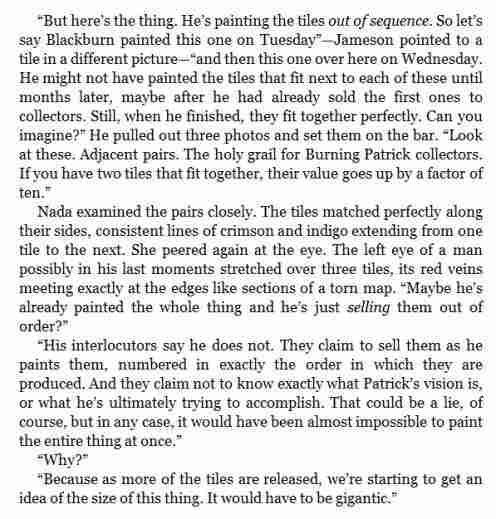See Harlan Kane and Guilfoile in this journal.
Tuesday, November 5, 2019
A Title for Harlan Kane: The Guilfoile Experiment
Tuesday, September 21, 2010
Patterns in the Carpets
"I know no writing— except perhaps Henry James's introductory essays— which conveys so clearly and with such an absence of fuss the excitement of the creative artist."
— Graham Greene on A Mathematician's Apology , review in The Spectator , 20 December 1940
"The mere quality and play of an ironic consciousness in the designer left wholly alone, amid a chattering unperceiving world, with the thing he has most wanted to do, with the design more or less realised— some effectual glimpse of that might, by itself, for instance, reward one's experiment."
— Henry James, "Prefaces to the New York Edition," in The Figure in the Carpet and Other Stories, Penguin Books, 1986, with introduction and notes by Frank Kermode
"What? You've found a pattern?"
— Greg Egan, "Wang's Carpets"
See also Notes on Mathematics and Narrative, with its discussion of the tiles of the creative artist Patrick Blackburn in the recent (August 2010) Pythagorean novel The Thousand and the discussion of Wang tiles in Modal Logic, a book from November 2002 whose author also happens to be named Patrick Blackburn.
(Credit for the Greene bibliographic information is due to Janelle Robyn Humphreys, whose doctoral thesis, Shadows of Another Dimension, was published in 2009 by the University of Wollongong.)
Tuesday, September 7, 2010
Burning Patrick —
Notes on Mathematics and Narrative
Background—
- The Burning Man in Bester's classic The Stars My Destination,
- The not-so-classic Hitler Plans Burning Man, and
- The cult film The Wicker Man
Commentary on The Wicker Man—
Originally The Wicker Man was not well-received by critics in the UK. It was considered
to be bizarre, disturbing, and uncomfortable, with the hasty editing making the story confusing
and out of order…. Today this movie is considered a cult classic and has been called
the “Citizen Kane of horror films” by some reviewers. How did this film become a cult classic?
Real estate motto— Location, Location, Location.
Illustration— The fire leap scene from Wicker Man, filmed at Castle Kennedy—

In today's New York Times, Michiko Kakutani reviews a summer thriller
by Kevin Guilfoile. The Thousand is in the manner of Dan Brown's
2003 The Da Vinci Code or of Katherine Neville's 1988 The Eight .
From the review—
What connects these disparate events, it turns out, is a sinister organization
called the Thousand, made up of followers of the ancient Greek mathematician
and philosopher Pythagoras (yes, the same Pythagoras associated with
the triangle theorem that we learned in school).
As Mr. Guilfoile describes it, this organization is part Skull and Bones,
part Masonic lodge, part something much more twisted and nefarious….
The plot involves, in part,
… an eccentric artist’s mysterious masterwork, made up of thousands of
individually painted tiles that may cohere into an important message….
Not unlike the tiles in the Diamond Theory cover (see yesterday's post)
or, more aptly, the entries in this journal.

A brief prequel to the above dialogue—

In lieu of songs, here is a passage by Patrick Blackburn
more relevant to the art of The Thousand—
See also the pagan fire leaping in Dancing at Lughnasa.
Friday, August 27, 2010
Mathematics and Narrative continued…
Narrative Sequence
In today's New York Times, Michiko Kakutani reviews a summer thriller by Kevin Guilfoile. The Thousand is in the manner of Dan Brown's 2003 The Da Vinci Code or of Katherine Neville's 1988 The Eight .
From the review—
What connects these disparate events, it turns out, is a sinister organization called the Thousand, made up of followers of the ancient Greek mathematician and philosopher Pythagoras (yes, the same Pythagoras associated with the triangle theorem that we learned in school).
As Mr. Guilfoile describes it, this organization is part Skull and Bones, part Masonic lodge, part something much more twisted and nefarious….
The plot involves, in part,
… an eccentric artist’s mysterious masterwork, made up of thousands of individually painted tiles that may cohere into an important message….
Not unlike the tiles in the Diamond Theory cover (see yesterday's post) or, more aptly, the entries in this journal.

